Menu
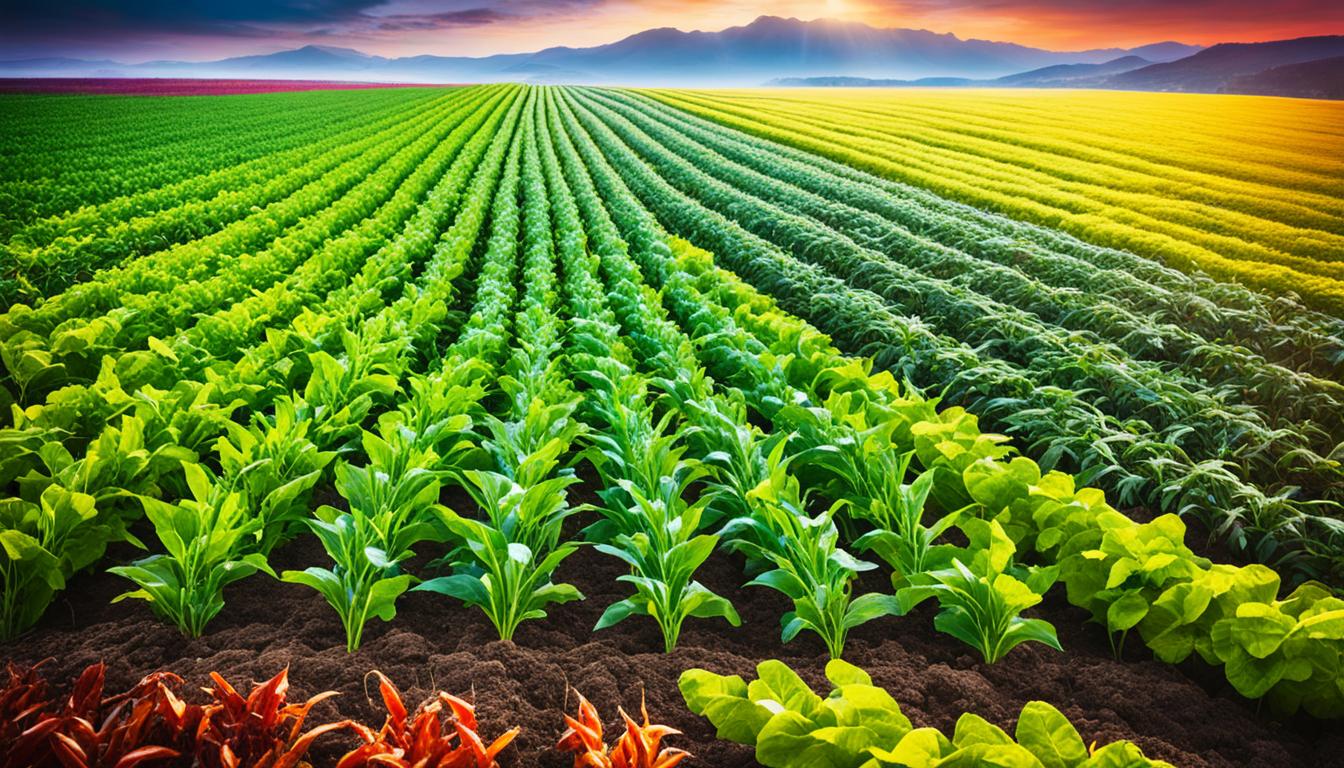
In 2012, biotechnology crops made up most of the U.S.’s corn, cotton, and soybeans. They were about 88%, 94%, and 93% respectively. This shows how important these crops are now. They offer more nutrition, resist pests and diseases, and give better harvests. Biotechnology is key in making farming sustainable and securing food for the rising global population.
Genetic engineering has changed agriculture for the better. It has brought many advantages, reshaping how we grow and look after crops. As we learn more, it’s clear that biotechnology is crucial for the future of farming. This piece will discuss the latest trends, tech, and effects of biotechnology crops. We will shine a light on their current position and their future.
Biotechnology crops, or GMOs, have changed farming for the better. By using genetic engineering, scientists improve plants. They make crops stronger against weeds and bugs. This method allows us to tweak plants to better fit our changing world.
GMO plants are changed through genetic engineering to get better traits. One key method is gene editing for precise plant improvements. These methods boost the plants’ resistance to weed killers and pests, plus improve their nutrition and ability to survive in various places.
Agricultural biotechnology started with old breeding methods for plants. But now, there’s been a big jump with genetic engineering for farming. In the United States in 2012, most corn, cotton, and soybean crops were GMOs.
This data shows how much GMO crops are a regular part of farming now. It proves they are helping to make farming better for the future.
Biotechnology crops help farmers save money and produce better quality crops. They also battle pests effectively, making farming more sustainable and fruitful.
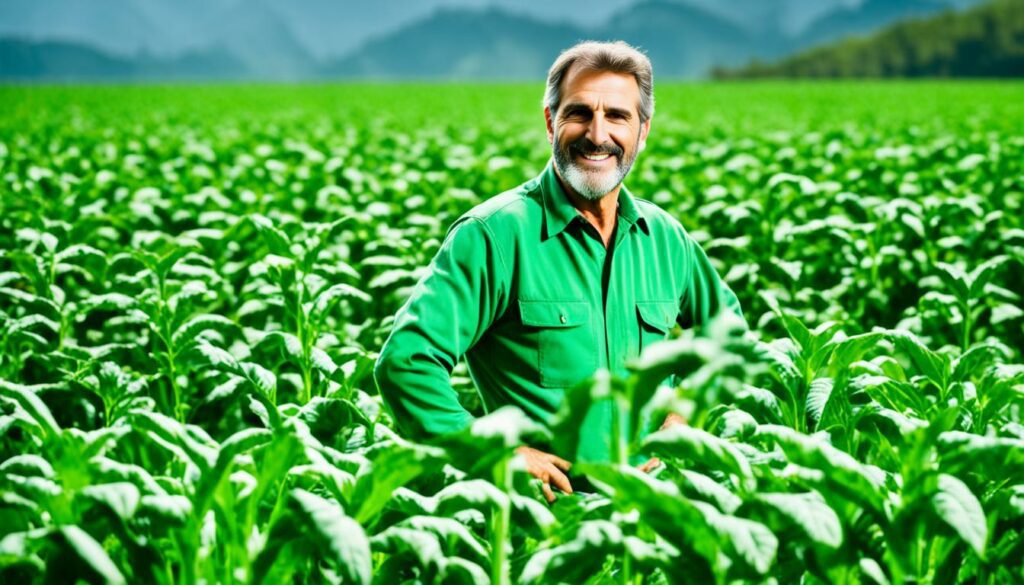
Biotechnology crops cut down on farming costs. They use less water, fertilisers, and pesticides. In the U.S., most corn, cotton, and soybeans grown in 2012 were biotech. This shows the savings they bring.
These crops fight off pests naturally. For example, insect-resistant cotton has cut the need for chemical insecticides. This means less harm to the environment and a more natural way of farming.
Biotech crops are known for their high yields. They produce more and better crops than traditional plants. For example, rice can have more beta-carotene and soybean oil can be of better quality. Herbicide-tolerant plants also mean less harmful weed killers are used.
| Crop Type | Percenage Adoption (2012) |
|---|---|
| Corn | 88% |
| Cotton | 94% |
| Soybeans | 93% |
Biotechnology boosts the farming world in many ways. It helps farmers make more money, meet food demands, and take care of the planet.
Biotechnology crops are changing how we farm for the better. By changing the genes of these crops, they need less pesticide and protect the environment. They are built to resist pests, so we use fewer harmful chemicals.
One key benefit of biotechnology crops is cutting down on pesticide use. In 2012, the majority of corn, cotton, and soybeans in the USA were biotech. They need less spraying, which is good for the environment.
These crops also save natural resources. Some are made to grow well without turning the soil over. This helps keep the topsoil from washing away. It also saves water and keeps the soil healthy for plants.
Biotechnology crops are a vital part of sustainable farming. They fight pests and save our earth’s resources at the same time.
GMOs have changed farming around the globe, in rich and poor countries. They are now key to modern farming. Leading countries include the United States, Brazil, and Argentina.
In 2012, the U.S. led the world by planting 88% of its corn, 94% of cotton, and 93% of soybeans as biotech plants. This shows how important these crops are for farming efficiency. Brazil and Argentina have also embraced biotech crops, showing their value for food security.
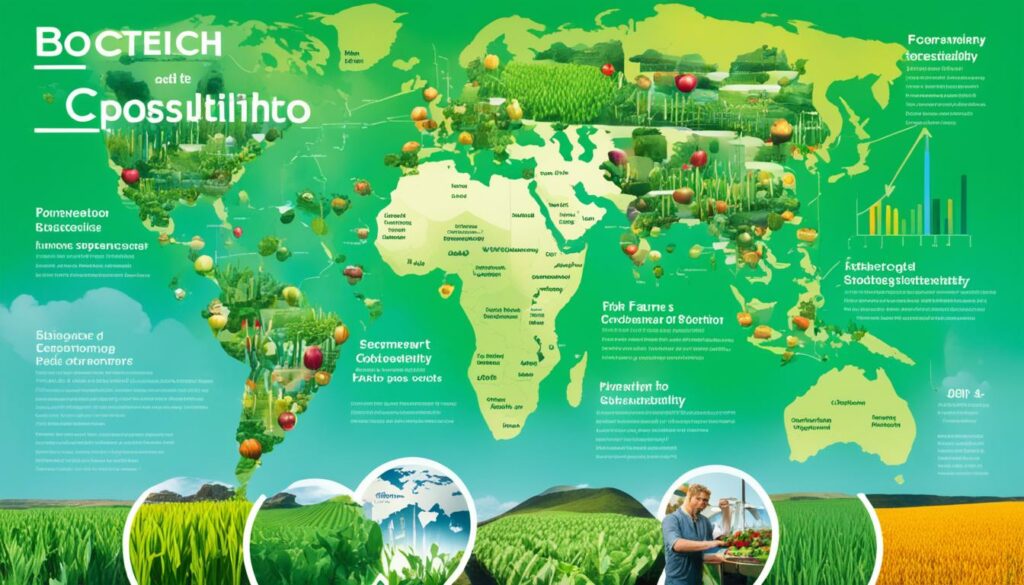
It’s not just rich nations that are growing biotech crops. By 2018, over 70 countries were doing it. Now, countries in Latin America, Asia, and Africa use these crops to fight hunger and improve farming. This shows the power of biotechnology to help agriculture everywhere.
GMOs are now widely accepted for their benefits in farming. They offer resistance to pests, increase yields, and make farms more profitable. This proves that genetically modified crops can meet the challenges of modern agriculture.
Recently, agriculture biotechnology has seen big changes, bringing new ways to make crops. These changes are key for making food more secure and in a way that lasts longer.
Now, we can edit genes using CRISPR-Cas9 and make RNA change how genes work. This lets us make crops better, like making food more nutritious or making them fight off diseases and pests. This is spreading worldwide, with more and more people using these new methods.
In 2012, most of the corn, cotton, and soybeans in the US were grown using biotechnology. This shows how important these new ways are in farming today.
There’s a lot more to come in making crops that can handle tough times like drought or salty soil due to climate change. With the world’s population growing fast, reaching 9.7 billion by 2050, making crops stronger and more productive is vital.
Costs for reading gene sequences are dropping fast. It cost about $2.7 billion to do the Human Genome Project in 1990. Now, it’s less than $300 and might soon be less than $100. This will help us make crops even better.
The USDA is working closely on this, keeping up with the latest on biotech crops. Also, they’re looking at new ways to pay for these crops based on how good they are, not just how many are sold. This pushes for farming that’s kind to the planet.
In short, biotechnology is changing farming in big ways. With new research and tools, we’re moving towards farming that’s both better for the planet and makes more food.
| Biotechnology Plantings (2012) | Percentage |
|---|---|
| Corn | 88% |
| Cotton | 94% |
| Soybean | 93% |
Biotechnology crops are key in the fight for food security. They boost both farm yields and nutrition. Genetically modified crops produce more per area than regular ones. For instance, biotech plants like corn, cotton, and soybeans in the U.S. reached high levels by 2012.
Thanks to biotech, farmers can grow more food. Crops are now designed to resist pests and diseases. Notably, soybeans that can tolerate weed killers and cotton that fights off insects are big hits. They allow farmers to use fewer harmful chemicals. This means they get more crops without risking their health or the environment.

Biotechnology also helps make crops more nutritious. For example, rice can be made with more Vitamin A to fight world hunger. This tackles malnutrition head-on. It’s a big help for people who need these extra nutrients the most.
Work has also gone into making potatoes, squash, and tomatoes tougher against disease. This helps ensure we can grow enough healthy food. It supports our aims for food security in the years to come.
Biotechnology is a game-changer for global food security. It makes growing food more efficient and the food itself better. This is vital for fighting hunger and malnutrition across the globe.
In conclusion, biotechnology’s work in agriculture and nutrition is crucial. It secures not just more food, but better food for tomorrow. Our fight against hunger and efforts for public health greatly benefit from these advances.
Biotechnology crops are doing great things for our planet. They help save different plant and animal species and make the soil healthier. These crops don’t need many chemicals thanks to their pest resistance, which is good for the environment.
Biotechnology crops play a big role in keeping our world’s plant and animal life varied. They use fewer chemical pesticides, which means the environment suffers less. Thanks to these crops, a lot less pesticide gets used. This is great news for all kinds of animals and bugs living in the area.
Biotechnology crops are now growing in almost all of the corn, cotton, and soy fields in the U.S. This shows just how important these crops are for our environment. They help save natural areas and keep different species of plants and animals safe.
Biotechnology crops also help keep the soil in good shape. They need less ploughing, which saves the land from eroding. This way, the soil stays moist and rich in nutrients. For example, some types of corn and wheat can grow in dry places without harming the soil.
The USDA tells us that biotech plants are key in making farming better for the land. They cut down on bad farming practices and help meet environmental goals. Without these crops, farming and forestry would cause even more air pollution.
Here’s a look at how much of the corn, cotton, and soy grown in the U.S. in 2012 was biotech:
| Crop | Biotechnology Plantings (%) |
|---|---|
| Corn | 88 |
| Cotton | 94 |
| Soybeans | 93 |
Biotechnology crops are really making a difference in how we farm. They keep the planet healthy by saving wildlife and keeping the soil rich. We must keep using this technology to help the environment even more.
Plant genetics and biotechnology have changed how we make crops better. Thanks to genetic engineering and gene editing in agriculture, our crops are getting more productive and healthier. Now, we’re making plants that give us more food, are better for us, and can handle tough conditions.
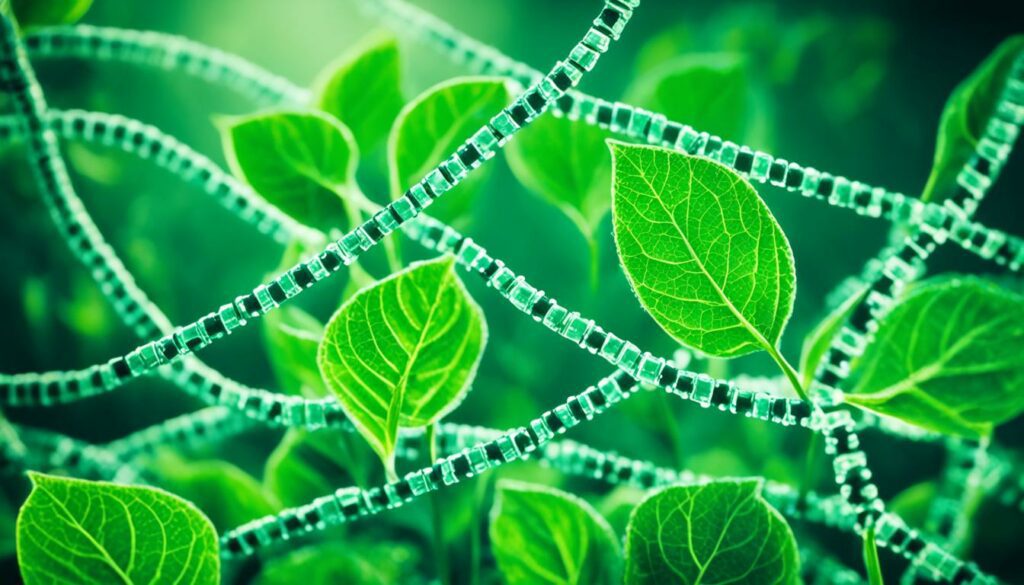
Genetic engineering is a big part of making plants better. It lets us add or change genes in plants to make them stronger. Plants can get traits like not being eaten by pests, being able to handle weed killers, or being more nutritious. In 2012, most of America’s corn, cotton, and soybeans were modified this way. This has made farming more efficient and less reliant on harmful chemicals.
New gene editing tools, like CRISPR-Cas9, are making precise changes to plant genes. This is done without adding new DNA. With this method, we can make crops that handle diseases, tough weather, and are more nutritious. These improved plants are helping to make sure there’s enough food and that farming can be more sustainable. In 2012, the use of these advanced techniques around the world grew a lot, showing people trust them.
People have mixed feelings about GMOs, considering their benefits, safety, and ethics. The way we see genetic engineering varies a lot. It’s a complex topic.
In the US, many people don’t know much about GMOs. Only 43% realised they could buy GM products at their local store. And just 59% knew they could buy GM soybeans. Some thought GM tomatoes, wheat, and chicken were in stores too. This lack of knowledge affects how people feel about GMOs.
Around the world, views on genetically modified foods are not the same. The US uses a lot of GM crops. For instance, most soybeans and corn are GM. Their use is wider, so more people accept them.
In Europe, GM crops are less popular. Only a small area grows insect-resistant corn. This shows how local feelings impact using genetic engineering in farming.
In both the US and UK, people would pay more for non-GM foods. This choice shows how much opinion on genetic engineering matters in buying food.
Farmers also see GM crops differently. In the UK, opinions vary a lot. But the US is a top producer of GM foods. This shows US farmers are more open to GM crops.
| Country | Hectares of GM Crops | Percentage of Global GMO Crop Production |
|---|---|---|
| United States | 73.1 million | 40% |
| Brazil | 42.2 million | – |
| Argentina | 24.3 million | – |
| India and Canada | 11.6 million each | – |
We need to keep helping people understand GMOs. Clear and open talks can make people more comfortable with GMOs. This could lead to using these new technologies more broadly.
The rules for biotechnology crops are detailed, making sure GMOs are safe. The Coordinated Framework started in 1986. It let the U.S. rule on biotech product safety.
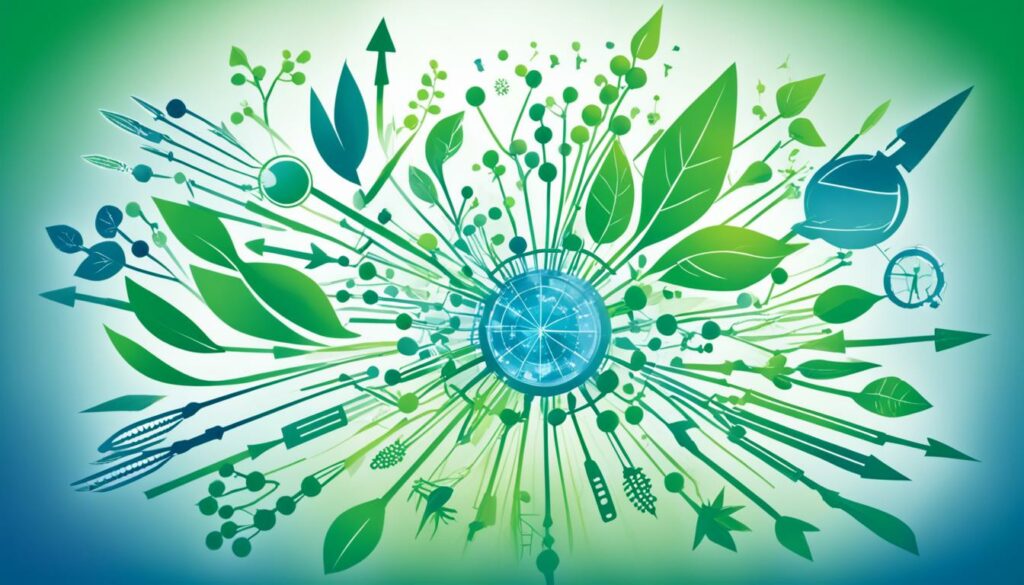
In the U.S., the EPA, FDA, and USDA-APHIS check on these crops. EPA looks at pesticides made by biotech. They follow the FIFRA.
Worldwide, how genetically modified plants are treated varies by country. Some are strict, others not so much.
The FDA ensures the safety of food from these plants. They also check the labels. This is to be sure they’re safe to eat and follow the rules.
Since 2003, thanks to the Codex Alimentarius Commission, there are global checks for safety. Things like toxins and allergies are looked at close.
WTO and the Cartagena Protocol help nations agree on safe rules for trading. The goal is global safety, based on science, for biotech products.
| Agency | Responsibility |
|---|---|
| USDA-APHIS | Regulates genetically engineered organisms deemed plant pests or posing plant pest risks. |
| EPA | Governs the use of biotechnology-derived pesticides under FIFRA. |
| FDA | Ensures the safety and labelling of genetically engineered food and feed. |
The spread of biotechnology crops has made a big economic difference. Markets have seen big growth worldwide, thanks to these crops. Their growth proves they’re valuable in solving farming issues and making more food.
In 2012, the U.S. saw a big use of biotech plants. About 88% of corn, 94% of cotton, and 93% of soybeans were developed through biotechnology. This shows that biotech crops help American farms produce more and better crops. Across the globe, the ISAAA found that these crops are well liked and show great economic potential.
Farmers who use biotech crops gain a lot economically. They get more crops that are high in quality. This helps their earnings grow. Also, these crops need less spending on pest control and disease. This saving, combined with better crop results, helps farmers earn more money. This shows the real impact of biotech crops in the market.
Biotech crops are more than just about money. They promise a bright future for farming. Let’s look at the many ways they are making a difference around the world:
| Region | Impact | Study Period |
|---|---|---|
| Global | Income and production effects | 1996-2010 |
| Romania | Impact of using Roundup Ready soybeans | Farm Level |
| Argentina | Farm level & aggregate welfare effects | Roundup Ready Soybeans |
| Ontario | Economic & environmental impacts | Commercial Cultivation |
| Brazil | Impact of GM crops | Various years |
Using biotechnology crops has great economic value and brings many benefits to farmers. These include making more food and saving money. Biotech crops are clearly important in today’s agriculture.
Biotechnology in agriculture has brought great success. Notably, insect-resistant cotton and herbicide-tolerant soybeans are making big impacts. These examples show how genetic engineering can change farming for the better. They boost yields, are good for the environment, and help farming be more sustainable.
Developing insect-resistant cotton has been a top achievement. It uses genes from a soil bacterium called *Bacillus thuringiensis* (Bt). This cotton variety produces proteins harmful to certain insects. As a result, there’s less need for chemical insecticides. This saves money for farmers and is good for the environment. It also keeps crop yields high, which is great for cotton farmers.
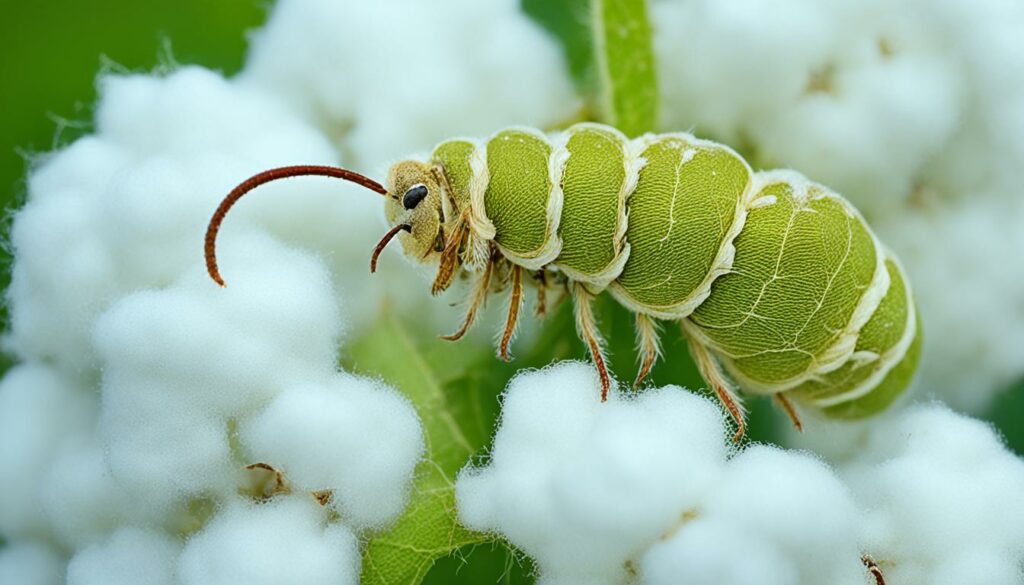
Another win in biotechnology is herbicide-tolerant soybeans. These soybeans are made to tolerate specific herbicides. This makes managing weeds easier for farmers. It also means they can use herbicides without hurting the main crop. Using these soybeans cuts down on labour, reduces costs, and helps the environment. Many farmers all over the world are planting these crops.
| Attribute | Insect-Resistant Cotton | Herbicide-Tolerant Soybeans |
|---|---|---|
| Primary Benefit | Reduces need for chemical insecticides | Effective weed management |
| Environmental Impact | Minimal pesticide usage | Reduced environmental impact of herbicides |
| Economic Benefit | Cost savings on pest control | Lower labour and weed management costs |
| Yield Impact | High yield stability | Consistent crop yields |
Biotechnology crops have brought big improvements to farming. But they face many hurdles. These include tough rules and negative views from the public.
Creating tech to make crops better and cheaper is a challenge. There are many strict rules to follow, and different places have different processes. For example, crops resistant to weed killers are not used much in Africa and South Asia. This is because they don’t always work well there and getting them approved is hard.
The push for biotech solutions mainly comes from companies wanting to sell products. But what farmers actually need isn’t always considered. In poorer countries, leaders find it hard to choose what to focus on due to lack of funds and knowledge. They also struggle without clear advice from their own experts.
| Region | Challenges |
|---|---|
| Africa | Lack of adapted herbicide-tolerant crops |
| South Asia | Limited regulatory frameworks |
Misunderstandings about GMOs are a big issue. Even though they can bring great benefits, people often worry about their safety. Helping people understand the science better is important. For example, making crops that don’t need as much weeding can be a good thing for some places.
Poor farmers often can’t easily get these new solutions. This happens because of the negative ideas about GMOs. It’s crucial to talk openly and honestly to overcome these challenges. This way, trust can grow, which is key for new farming technologies to succeed.
Overcoming difficulties with rules and changing public opinions is crucial. Only then can biotechnology be widely used and bring its full benefits to farming.
Climate change is a big issue for farming today. But, biotechnology crops offer hope. They can reduce climate change’s effects and help us deal with its ups and downs in agriculture.

Biotechnology crops are key in battling climate change. The USDA says farming and forestry made up about 10.5% of U.S. greenhouse gas emissions in 2018. With biotech, we can make crops that need fewer resources.
No-till farming, encouraged by biotech, traps carbon in the soil. Drought-tolerant crops like corn and wheat need less water. This cuts down on the pollution caused by farming.
Biotech crops also help us adapt to changing climates. They’ve made wheat, rice, tomatoes, soybeans, and cotton that can survive droughts. For example, drought-tolerant corn is grown in dry parts of the U.S.
They’ve even bred cattle that can withstand more heat. This is important for keeping livestock healthy as the planet warms.
| Crop | Region | Biotech Trait |
|---|---|---|
| Corn | U.S. | Drought Tolerance |
| Wheat | Argentina, Brazil | Drought Tolerance |
| Cattle | Global | Heat Tolerance |
Growing these biotech crops makes our food system stronger. It makes us less vulnerable to wild climate swings. As we learn more, new biotech ideas will help make farming sustainable and fight climate change’s effects.
In the future, biotechnology will change agriculture significantly. It’s about more than increasing crop amounts. It also brings great economic, environmental, and nutritional benefits.
Take potato yield for example. Tissue culture can make thousands of kilograms from just one tuber. This shows how biotech can really increase productivity.
Genetically changing crops like cassava and rice makes them more nutritious. This is a big step in fighting malnutrition, helping small farmers in poor countries. It means they won’t need as many expensive chemicals.
There’s also less need for harmful pesticides thanks to biotech. This is because things like insecticidal fungi can be made in large amounts and kept. It’s better for the environment and for farming.
As these new biotechnology products spread, we’ll need to manage them well. It might be hard with the current control systems. So, we need strong and clear rules for keeping these new things safe.
But, the benefits of biotech crops are huge. They help produce more food, fight climate change, and secure our food for the future. By using these new technologies right, we can make a food system that’s strong and lasts. This will help feed more people in the world.
Biotechnology crops are plants changed at the genetic level. This process adds good traits like the ability to resist bugs and not be harmed by some weed killers. These plants are often called GMOs.
They make farming more sustainable. This is by using fewer pesticides and saving natural resources. They also help the soil and its life stay healthy.
Farmers find these crops very useful. They make farming cheaper and offer protection from bugs and diseases. The crops can be of better quality and sometimes, give a higher yield.
The leading countries are the United States, Brazil, and Argentina. Also, developing nations are using this technology more each day.
Now, new technologies like CRISPR-Cas9 are becoming more common. These aim to make crops better able to handle different environments and more nutritious.
They boost food security by increasing how much we can grow. They also make food more nutritious. This helps with both the amount and quality of our food.
Biotechnology crops can help the environment. By needing less chemical help and protecting the soil, they support wildlife and keep the earth healthier.
Understanding the genetics of plants is key. It helps scientists make crops that grow better, resist diseases, and produce more.
What people think, like if they trust the benefits or worry about safety, really matters. It affects how much we use these crops. Talking to the public about this is very important.
Strict rules are in place for making and selling these crops. They check that the crops won’t harm us or the environment. These rules are very careful and meant to keep us safe.
Biotechnology crops are good for the economy. More use of them means the market is growing. This helps farmers make more and spend less, which is good for everyone.
Insect-resistant cotton and herbicide-tolerant soybeans are two success stories. They have cut down on the need for pesticides and made farming weeds easier. They show how useful biotechnology can be.
There are some tough problems, like dealing with different rules and what people believe. These can slow down how much we use these crops and the good they can do.
They can help by making plants that can thrive in difficult conditions. Using certain farming methods can also help cut down on harmful gases. This makes our food system more ready to handle changes in the weather.